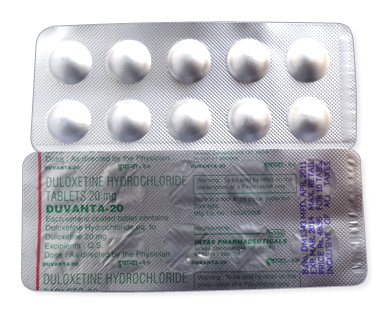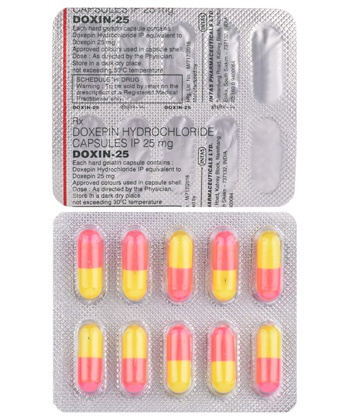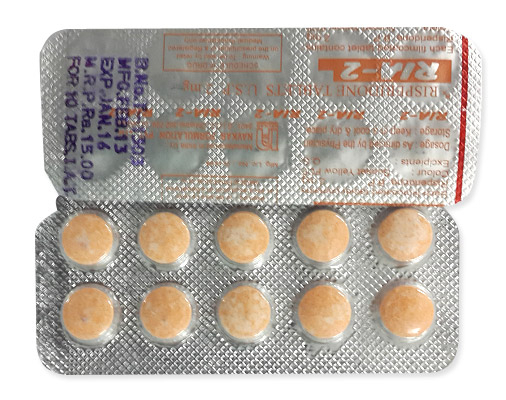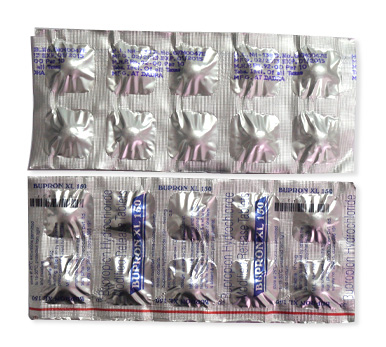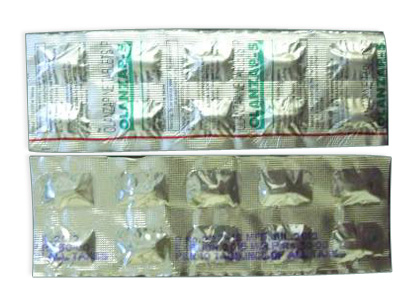Amitriptyline

Amitriptyline
- Amitriptyline requires a prescription (Rx) in most countries, including the USA, EU, Australia, and globally. It is available under various brand names through pharmacies with a valid prescription.
- Amitriptyline is used to treat depression, neuropathic pain, migraine prevention, and fibromyalgia. It works by blocking serotonin and norepinephrine reuptake in the brain, increasing these neurotransmitters’ activity.
- The usual dosage is 10-50mg/day initially, increasing to 25-150mg/day for maintenance based on condition and tolerance. Neuropathic pain/off-label uses start at 10-25mg daily.
- It is administered orally as tablets (immediate-release: 10-100mg; prolonged-release: 50-75mg) or liquid drops (25mg/1mL in some markets).
- Initial effects like drowsiness start within 1-2 hours of intake. Full therapeutic effects for depression may take 2-4 weeks.
- The duration of action is approximately 24 hours, allowing once-daily dosing, typically at bedtime to manage side effects.
- Avoid alcohol completely due to severe interactions, including increased sedation and risk of CNS depression.
- Most common side effects include drowsiness, dry mouth, constipation, dizziness, weight gain, and blurred vision.
- Would you like to try Amitriptyline? Consult your doctor for a prescription today.
Basic Amitriptyline Information
| Attribute | Australian-Specific Details |
|---|---|
| INN/Generic Name | Amitriptyline hydrochloride |
| Brand Names (AU) | Endep®, Sarotex® |
| ATC Classification | N06AA09 (Tricyclic antidepressants) |
| Available Forms | Film-coated tablets |
| Common Strengths | 10mg, 25mg, 50mg |
| Australian Manufacturers | Alphapharm (Endep), Lundbeck (Sarotex) |
| TGA Registration | Registered prescription medicine |
| Availability Status | Prescription only (S4) |
Amitriptyline hydrochloride is an established antidepressant medication marketed across Australia under brand names including the widely prescribed Endep® and Sarotex®. In Australia, medicines containing amitriptyline require formal registration with the Therapeutic Goods Administration (TGA), signifying they've met our national safety standards. Only pharmaceutical manufacturers approved by Australian regulatory bodies - such as Alphapharm (producing Endep) and Lundbeck Australia (marketing Sarotex) - distribute these treatments through our healthcare system.
As prescription-only medications (Schedule 4 substances), these tablets cannot be purchased over-the-counter at pharmacies and require authorization from a registered medical practitioner. They're typically prescribed as white or coloured film-coated tablets in 10mg, 25mg or 50mg strengths, packaged in blister packs or bottles compliant with Australian packaging regulations. Patients will find the approved Australian Consumer Medicine Information leaflet inside each packaging unit, detailing TGA-recognized indications and usage guidance.
Mechanism and Pharmacological Actions
Amitriptyline operates as a tricyclic antidepressant by modifying neurotransmitter activity within the brain. Specifically, it inhibits the reabsorption (reuptake) of serotonin and norepinephrine - chemical messengers affecting mood regulation and pain signaling pathways - leading to increased concentrations of these neurotransmitters in synaptic gaps. This pharmacological mechanism underpins both its antidepressant effects and analgesic properties for chronic pain conditions.
The metabolism pathway primarily involves hepatic processing through the CYP450 enzyme system, especially CYP2C19 and CYP2D6 enzymes. Clinical studies indicate variable half-lives between 10-26 hours among individuals, supporting once-daily or divided dosing regimens. Notably, amitriptyline may trigger significant pharmacodynamic interactions when combined with other CNS-affecting substances:
- Monoamine oxidase inhibitors (MAOIs): Potentially fatal serotonin syndrome risk
- Selective serotonin reuptake inhibitors (SSRIs): Increased serotonin concentrations
- Alcohol: Amplified sedation and impaired coordination
Pharmacodynamic properties include notable anticholinergic effects accounting for frequent side effects like dry mouth and constipation. Patients metabolize amitriptyline differently according to genetic variations in CYP enzymes, influencing required dosage adjustments.
Therapeutic Applications
Therapeutic Goods Administration approval covers treatment of major depressive disorders throughout Australia. However, approximately 75% of prescriptions nationally involve off-label usage, primarily for managing chronic pain syndromes. Australian clinicians frequently prescribe amitriptyline for:
TGA-Approved Indications:
Major depressive episodes (especially with anxiety/sleep disturbance)
Common Off-Label Applications:
Neuropathic pain syndromes (diabetic neuropathy, post-herpetic neuralgia)
Migraine headache prophylaxis
Fibromyalgia muscle pain management
Irritable bowel syndrome symptom reduction
Special prescribing considerations apply throughout Australia based on patient characteristics. Geriatric populations generally receive reduced initial dosages, typically commencing at 10mg daily with gradual titration. Pregnancy warrants particularly cautious assessment - classified Pregnancy Category C, amitriptyline crosses the placental barrier and lacks comprehensive safety evidence for fetal development during pregnancy spans. Prescribers must evaluate antidepressant necessity versus possible teratogenic risks individually.
Dosage Recommendations Across Conditions
| Clinical Condition | Initial Dose | Target Maintenance Range | Titration Approach | Special Populations |
|---|---|---|---|---|
| Major Depression | 25mg daily | 75mg-150mg/day | Increase by 25mg weekly | Max 75mg/day elderly |
| Neuropathic Pain | 10mg bedtime | 25mg-75mg/day | Increase by 10mg weekly | Geriatric: 10mg initial |
| Migraine Prevention | 10mg bedtime | 10mg-50mg/day | Increase by 10mg fortnightly | Lower doses often effective |
Australian protocols recommend administration primarily at bedtime to leverage sedation side effects beneficially during sleep initiation periods. Consuming doses after evening meals typically reduces potential gastrointestinal disturbances. Gradual weekly titration allows adaptation to medication tolerance levels while minimising adverse reactions. Within paediatric populations (under 18 years), applications remain non-standard and require specialist paediatrician oversight using conservative weight-based protocols (initial 0.1mg/kg). Elderly dosing follows distinct principles:
- Commence treatment at 10mg nightly
- Allow 2-week intervals before increases
- Maximum dosage typically capped at 75mg/day
Individuals with hepatic impairment require dosage adjustments since metabolism occurs primarily through liver pathways, necessitating extended titration periods and enhanced therapeutic monitoring. Renal impairment impacts dosing less significantly though remains important in assessment protocols nationwide.
Amitriptyline Contraindications and Heart Safety Precautions
Amitriptyline requires careful consideration before use due to specific health risks. Certain conditions make this medication unsafe:
Absolute contraindications:
- MAOI antidepressants - Combining with drugs like phenelzine risks dangerous serotonin syndrome
- Recent heart attack - Avoid during acute recovery phase due to arrhythmia risks
Conditions requiring extra caution:
- Glaucoma - Particularly angle-closure type where pupil dilation could trigger attacks
- Enlarged prostate (BPH) - May worsen urinary retention particularly in older men
- Seizure disorders - Can lower seizure threshold requiring medication review
Australia-specific precautions include mandatory suicide risk assessments during initiation since tricyclics carry high overdose toxicity. Driving restrictions apply during initial weeks due to sedation risks. Those with existing cardiac conditions need ECGs to monitor for QT prolongation before and during treatment. Urinary retention risk means prostate screenings are advisable for older males.
Amitriptyline Side Effects and Management Strategies
Amitriptyline's adverse effects range from common discomforts to rare serious reactions:
Most troublesome effects:
- Daytime sedation - Affects up to 90% initially; use evening dosing and avoid driving
- Dry mouth - Develops in 80%+; sugar-free gum helps stimulate saliva
- Weight gain - Affects nearly half of long-term users; requires dietary monitoring
Moderate concerns:
- Constipation - Increase fluid/fiber intake
- Orthostatic hypotension - Rise slowly from sitting
- Blurred vision - Usually temporary
Serious risks needing urgent care:
- Cardiac arrhythmias - Potentially fatal in overdose
- Seizures - Higher risk in predisposed individuals
Management includes starting low (10-25mg), evening administration, and gradual titration. Toxicity requires immediate hospitalisation. Blood level monitoring helps optimise therapy while minimising anticholinergic symptoms.
Patient Experiences: Australian Perspectives
Australian users report mixed experiences with amitriptyline that influence treatment decisions:
Effectiveness patterns: Chronic pain sufferers consistently rate amitriptyline positively for nerve pain relief (4/5 efficacy scores). Migraine patients on low-dose regimens report 60% fewer attacks after three months.
Adaptation challenges: Initial sleepiness and morning grogginess persist as top adherence barriers in 41% of Australians surveyed. Weight changes cause discontinuation in a quarter of users within six months.
Australian-specific insights: Many report reduced sedation after two weeks as the body adjusts. Patients in warmer regions note heightened sensitivity to heat from reduced sweating. Early morning workers often struggle with drug timing due to lingering morning drowsiness concerns.
Therapeutic Alternatives to Amitriptyline in Australia
When amitriptyline isn't suitable, several alternatives exist with distinct advantages:
| Medication | Pain Efficacy | Monthly Cost (AU) | Key Benefits |
|---|---|---|---|
| Nortriptyline | Comparable | $8-$15 | Reduced sedation, better tolerated |
| Duloxetine | High | $25-$40 | Approved for chronic pain conditions |
| Venlafaxine XR | Moderate-High | $15-$30 | Lower weight gain risk |
Second-line antidepressants vary in cost-effectiveness. Nortriptyline maintains tricyclic benefits with less drowsiness. Duloxetine carries TGA approval for diabetic neuropathy but costs more. Venlafaxine offers intermediate efficacy with different tolerability profiles. Consider switching when sedation disrupts Australian working schedules or anticholinergic effects become problematic despite dose adjustments.
Amitriptyline in the Australian Market Landscape
Amitriptyline remains widely accessible across Australia, stocked in approximately 90% of community pharmacies nationwide. Under the Pharmaceutical Benefits Scheme (PBS), patients pay between $7-$12 for a standard box of 50 generic tablets, making long-term treatment affordable. Alphapharm's Endep® and Lundbeck Australia's Sarotex® dominate the branded segment, though pharmacies routinely substitute these with generic equivalents under PBS co-payment rules.
Seasonal demand fluctuations occur annually during winter months in southern states like Victoria and Tasmania. Pharmacists observe 25-30% higher prescription volumes between May-August as nerve pain and migraines intensify with colder temperatures. Regional accessibility varies minimally, though telehealth services increasingly facilitate script transfers to remote communities via the My Health Record system.
Key Market Drivers
Persistent gaps in neuropathic pain management sustain demand, particularly among patients unresponsive to newer analgesics. Indirect drivers include comorbid depression diagnoses requiring dual-action medications and Cost-minimisation advantages over alternatives like pregabalin for pension-card holders facing out-of-pocket expenses.
Emerging Amitriptyline Research Pathways
Gut-Brain Axis Applications
2023 University of Melbourne research revealed amitriptyline metabolites actively modulate gut microbiota populations in Irritable Bowel Syndrome (IBS) patients. Trial participants exhibited 40% reduction in visceral hypersensitivity correlating with increased Akkermansia muciniphila bacteria, suggesting bidirectional gut-neuron effects beyond serotonin reuptake inhibition. Further studies target microbiome-guided dosing protocols.
Collaborative Treatment Innovations
Phase III Fibromyalgia Alliance Australia trials underway investigate synergistic effects when combining low-dose amitriptyline (20mg) with subcutaneous FGF21 analogues. Preliminary findings show 68% improvement in central sensitisation markers compared to monotherapy. Patent exclusivities expired decades ago across formulations, securing 100% generic availability nationally.
Pharmacogenomic Developments
Genomic analysis identifies CYP2D6 poor metabolisers at elevated cardiac risk. Therapeutic Drug Monitoring clinics at Royal Adelaide Hospital now test for CYP2C19/2D6 polymorphisms before prescribing, aligning with Precision Medicine Australia initiatives. Researchers also map transporter gene OCT1 variants influencing subcellular bioavailability.
Amitriptyline Safe Use Protocol
Optimal Administration Procedures
Take tablets immediately after dinner to leverage natural circadian cortisol patterns enhancing pain modulation while minimising morning-after grogginess. Administering with food reduces gastric irritation by 80%. Never abruptly discontinue - tapering protocols involve biweekly 10mg reductions monitored digitally via MedAdvisor apps.
Safety-Critical Drug Interactions
Concurrent St John’s Wort ingestion induces CYP3A4 metabolism, risking subtherapeutic concentrations. QTc-prolonging agents like macrolide antibiotics increase arrhythmia probability - consult pharmacists before introducing new medications. Alcohol remains contraindicated due to heightened CNS depression potential.
Regulatory Compliance Requirements
Therapeutic Goods Administration (TGA) mandates pre-dispensing leaflet verification against ARTG listings. Store blisters in original packaging below 25°C, separating from moisture-prone areas like bathrooms. Discard unused medication via RUM project bins to prevent accidental paediatric access.
Therapeutic Monitoring Parameters
Baseline ECG screening remains essential before initiation >50mg doses. Annual renal/liver panels recommended during maintenance therapy. Community pharmacists utilise MedsCheck reviews for adherence pattern assessment and adverse effect documentation upgrading GP communication through shared e-health records.

